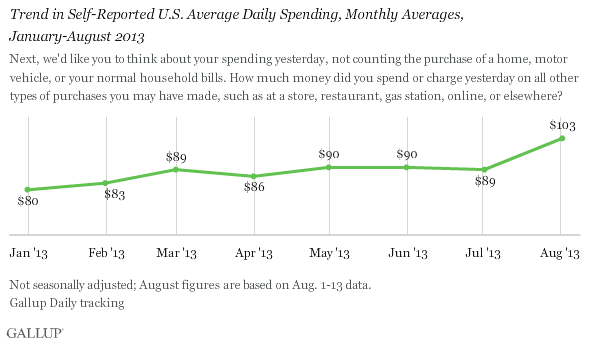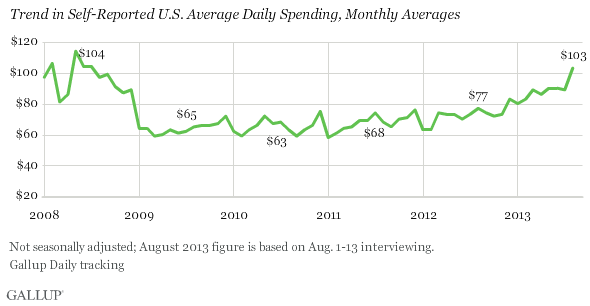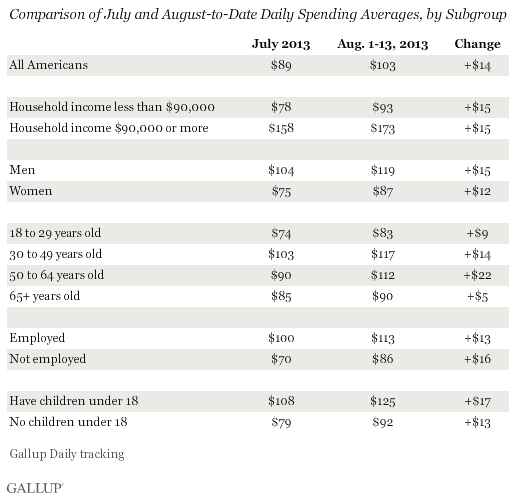PRINCETON, NJ -- Americans' self-reported daily spending has increased significantly in the early part of August, averaging $103 so far this month after averaging around $90 in each of the prior three months.

Gallup asks Americans to report how much they spent the prior day, excluding payments for normal household bills and major purchases such as homes or cars. The figure gives an estimate of discretionary spending. The August-to-date figure is based on Aug. 1-13 Gallup Daily tracking interviews with more than 6,000 U.S. adults.
If August spending continues at its current pace, it would mark the first time since July 2008 that Gallup's spending trend has averaged more than $100 per day for an entire month. Even if spending declines in the latter part of August, as has been common in the past few years, it seems likely that this month's final spending estimate will be the highest monthly average since the fall of 2008.

The longer-term spending trend suggests that Americans may be breaking out of the lower "new normal" spending pattern that existed from 2009-2012 after the recession. Gallup's spending estimate averaged below $80 from January 2009 through November 2012, and was below $70 most of those months. Since December 2012, the estimates have averaged $80 or more each month.
Gallup does not ask Americans to specify what they are spending the money on, just the amount. Thus, it is unclear what types of purchases are driving the August increase. There are certainly factors that may cause Americans to increase their spending in early August as opposed to other times of the year, including back-to-school shopping and summer recreation. However, Gallup has not consistently seen the same July to August spending increase in prior years. Thus, seasonal variations in spending alone do not explain the August increase -- unless Americans were limiting their back-to-school and vacation spending in recent years but now feel freer to spend their dollars in those areas.
Gas prices may also help explain the increase. Although they have dropped in recent days, gas prices remain high on a relative basis. If Americans are feeling like vacations are more economically feasible for them this year, higher gas prices plus increased driving could be contributing to the increase in spending.
Spending Generally Up Across the Board
All key subgroups show at least modest increases in spending for August to date, compared with July.
As would be expected, given the back-to-school season, spending among those with children younger than 18 is up significantly this month vs. July (from $108 to $125), but it is also up among non-parents (from $79 to $92).

Notably, lower- and middle-income as well as upper-income Americans show increased spending from last month. In the past, Gallup has found that spending among upper-income Americans usually drives the trend in overall spending, since lower- and middle-income spending tends to be more stable. Thus, it is a positive sign for the economy that spending is up among the more sizable lower- and middle-income group.
Implications
The importance of increased consumer spending is obvious, given that it accounts for roughly 70% of the U.S. economy. Although the economy since 2009 has managed to avoid slipping back into recession, economic growth has been sluggish. The recent pullback in government spending, which was further driven by the federal budget sequester that went into effect in March, has been a factor in the sluggish growth. That puts more of the burden on consumers and the private sector to restore the economy to good health.
It is unclear whether consumer spending will continue to remain at its higher rate the rest of the month and beyond. Even if it falls back to more typical 2013 levels, the generally higher levels of consumer spending this year compared with prior years are a definite sign that consumers are feeling better about the economy and their own financial situations.
Gallup.com reports results from these indexes in daily, weekly, and monthly averages and in Gallup.com stories. Complete trend data are always available to view and export in the following charts:
Daily: Employment, Economic Confidence, Job Creation, Consumer Spending
Weekly: Employment, Economic Confidence, Job Creation, Consumer Spending
Read more about Gallup's economic measures.
View our economic release schedule.
Survey Methods
Results for this Gallup poll are based on telephone interviews conducted Aug. 1-13, 2013, on the Gallup Daily tracking survey, with a random sample of 6,613 adults, aged 18 and older, living in all 50 U.S. states and the District of Columbia.
For results based on the total sample of national adults, one can say with 95% confidence that the margin of sampling error is ±2 percentage points.
The margin of error for the spending mean is ±$8.
Interviews are conducted with respondents on landline telephones and cellular phones, with interviews conducted in Spanish for respondents who are primarily Spanish-speaking. Each sample of national adults includes a minimum quota of 50% cellphone respondents and 50% landline respondents, with additional minimum quotas by region. Landline and cell telephone numbers are selected using random-digit-dial methods. Landline respondents are chosen at random within each household on the basis of which member had the most recent birthday.
Samples are weighted to correct for unequal selection probability, nonresponse, and double coverage of landline and cell users in the two sampling frames. They are also weighted to match the national demographics of gender, age, race, Hispanic ethnicity, education, region, population density, and phone status (cellphone only/landline only/both, and cellphone mostly). Demographic weighting targets are based on the March 2012 Current Population Survey figures for the aged 18 and older U.S. population. Phone status targets are based on the July-December 2011 National Health Interview Survey. Population density targets are based on the 2010 census. All reported margins of sampling error include the computed design effects for weighting.
In addition to sampling error, question wording and practical difficulties in conducting surveys can introduce error or bias into the findings of public opinion polls.
For more details on Gallup's polling methodology, visit www.gallup.com.
